You are reading the older HTML site
Positive Feedback ISSUE
19
may/june 2005
cary audio
CAD-805 Anniversary Edition Class A Triode amplifiers
as reviewed by Sasha Matson
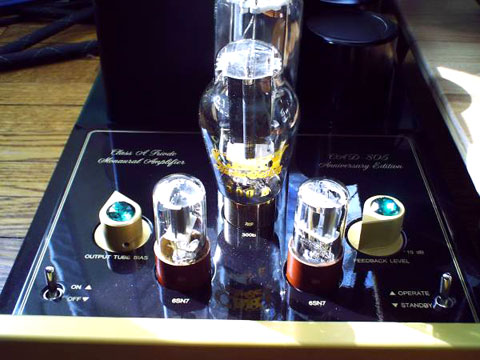
|
SASHA MATSON'S SYSTEM
LOUDSPEAKERS
ELECTRONICS
SOURCES
CABLES
ACCESSORIES |
For Ten Years, You Get…
It is my Anniversary… no, not that lovey-dovey stuff with the wife. I am talking about the two large wooden crates and a third box of tubes, which arrived from North Carolina about two months ago. The mighty Cary Audio 805 Anniversary Edition Class A Triode Amplifiers. This has been a tough piece to get written—for a very simple reason. Every time I intend to get to work at the laptop, I find myself back in the living room instead, listening and marveling at these things!
Some of the finest ears, and writers connected to them, in the audio world, have addressed the evolution of the Cary Audio '805s' (as I will henceforth refer to them as), since their inception in 1993. In addition, these are literally a large pair of shoes to step into: the 805 monoblocks measure one foot wide by two feet deep, and weigh 85 lbs. per unit.
So there they sit, in all their British-American single-ended triode splendor. Why do I say British? Because this pair of 805s are only the second pair on the planet that Cary Audio has produced which are finished in Jaguar British Racing Green automotive enamel paint for the chassis! (More on this in a moment.) How cool is that you ask? Very. Look at the photo I have to prove it...
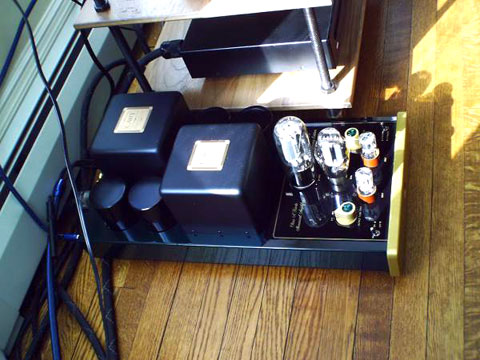
Jumping To Conclusions
I've decided to write this article in reverse order not only because there is a considerable history with the 805s that needs to be addressed, but because in the course of this project I visited the Cary Audio facility in Apex, North Carolina, and I want to share some of those photos with you, as well as some of the conversations I had with Dennis Had, Designer and CEO, as well as with his colleagues at Cary.
Therefore, for those of you who like to 'open up the centerfold' first, so to speak, here are my conclusions:
Building on both a record of serious creative innovation and intensive product development and refinement over a period of years, the current CAD-805 Anniversary Edition amplifiers are at the heart of what the 'High-End' means, and what it aspires to be. The 805s stand alone and unique as a standard-bearer for the art and craft of true music re-creation. Superbly engineered and realized, designed with the ear of an artist and the insight of a master inventor operating at the highest levels of musical and technical aesthetics, the 805s bring new meaning to the art of critical listening. From thundering lows to the most delicate and ethereal of highs—or as Bob Dylan said in tribute about Jerry Garcia, 'from the swamp to the stars.' Once you hear the mighty CAD-805s there can be no turning back—you will want these music makers to be part of your life. For those who value the emotional imperatives of music and must find a way to make music truly a part of your ongoing daily waking existence, the CAD-805s are powerful enablers; they are proactive. Harmonic truth, dynamic life, timbral subtleness, breathing living music! For this listener, the 805s are not a luxury—they are a necessity.
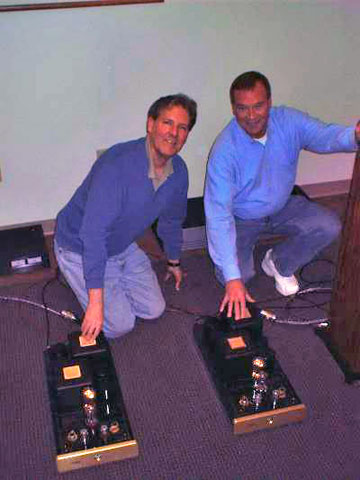
S.M. and Dennis Had petting the 805s
The Circle of Cary
And as David Byrne says, "Well... how did I get here?" I first had any personal contact with Dennis Had and Cary Audio when I interviewed him at the 2003 CES show in Vegas. I then reviewed the Cary 308T CD player for PFO, and ended up purchasing that unit, I liked it so much. (read Sasha's review here) In a strange moment of déjà vu, or some such psychic phenomena, I mentioned at that time the fine music I was hearing wafting in from the other room, as I chatted with Dennis Had at the Alexis Park hotel. At the time, ( January, 2003), I noted that "the renowned CAD-805 monoblock amplifiers turned ten this year, and in their honor Dennis Had brought out a special Anniversary Edition of that great music maker." Now in spring 2005, I finally get the pleasure of having those same 805s I had only read about and heard in passing, right here in my living room in all their righteous glory!
So now, 'the worm turns again.' For me it is a matter of closing a circle that has been in progress for some time with Cary Audio. By this, I mean to echo some similar thoughts I expressed in the last PFO issue regarding AudioQuest and their fine high-end cable products (read Sasha's review here). AudioQuest and Cary Audio are the two hardware manufacturers that I have had the closest personal contact with over time, since I became interested in high-end audio in the first place. I feel it behooves me to extend to these companies due consideration, having lived with that gear, listened, and come to know the products over time.
The first Cary Audio product I actually owned, I purchased several years back from my friends at Audio Classics, located in Binghamton, New York. (You can check out what they offer at www.audioclassics.com ) Steve and the boys there do an excellent job of rehabilitating classic stereo designs. I wanted at the time to experience a 300B-type single-ended tube design. So I became the proud new owner of a handsome pre-owned pair of Cary Audio 300SE monoblocks. This model, along with the 805s, have been continuously produced by Cary over a number of years, incorporating technical improvements and changes, but still maintaining the fundamental designs that Dennis Had first created for them.
When I auditioned the Cary 300SEs, I was taken with them in conjunction with a pair of Sonus Faber Concertos. I promptly bought both the Cary amps and the speakers at the same time. I had never experienced in my home that caliber of audio reproduction before, and it was love at first hear! I spent many contented evenings curled up by the fire—the 300SEs with their 300B tubes softly glowing, producing wonderful sound through the two-way largish bookshelf-sized Sonus Fabers.
Having later added the wonderful Cary Audio 308T CD player to my 'A' setup, and getting to know some of Dennis Had's views on audio and music, I gladly accepted his invitation to review the 50-watt push-pull triode monoblocks he had been working on for some time for his Audio Electronic Supply moniker, which he dubbed "Sixpacs." I ended up reviewing the first pair Dennis produced, and I stand by every word I wrote then; the mighty little 'Sixpacs' enriched my musical life, and I purchased that review pair (read Sasha's review here).
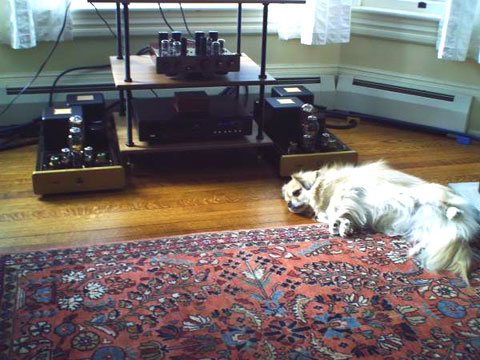
Ollie bonds with the alpha amps
Returning to my pals at Audio Classics once again in Binghamton, we figured out that I have been following around the same dissatisfied audiophile, (you know the type), and benefiting from his trade-ins. I became the owner of another of this same person's castoffs- in this case a barely, if at all, broken-in pair of Sonus Faber Grand Piano floor-standers. These are very similar to the Concerto model; they take that basic design and add to it by incorporating a second woofer and a front-ported full-size cabinet. However, they actually are a more efficient design, coming in at around a 90dB figure. Those couple of dBs in the rating really made a big difference! The resulting 2-and-a-half-way design is an aural beauty, and all things being relevant, I think they are an outstanding musical value that is perhaps not as noticed as some of Sonus Faber's other pricier and flashier models—check them out.
Yet the audiophile mind is a restless and fickle thing! There it was staring me in the face- the Cary Audio SLP98P preamp I had purchased last spring. This has been another long-running outstanding model in the Cary pantheon. My neighbor here in up-state New York, Art Dudley, had many very positive things to say about it in a recent review in that 'other' audio magazine. As a fairly educated high-end listener and reader, I, like many of you, have read a number of reviews and articles over the years that discussed the mighty Cary 805. What, I said to myself, might they sound like driving my Sonus Faber floor-standers, with the rest of the electronics already being top-flight Cary Audio designs? (Art Dudley assigned the CAD SLP98 without qualms to the "A" category of 'recommended components' in that other audio magazine.)
So I phoned up Dennis Had at his lair there in Apex, North Carolina, and I asked him a simple question to which I wanted a direct answer: "Dennis, if I put a pair of your 805s in my system, will I notice a difference between them and the 'Sixpacs'?" To which he answered: "Yes".
What It Was/What It Is
The CAD-805 Anniversary Edition is the fourth edition in the 805 series to be designated with a different model label. The first version employed an 805-type output tube, hence the original model name, but this tube was replaced early on by a 211 output tube. However, the series of models has retained the '805' designation. Subsequent versions have also utilized the 845 output tubes, which are very similar in appearance and specs to the 211 tubes, but nonetheless different in their sonic behavior.
Here is what you will see with a pair of CAD Anniversary 805s, moving from front to back. The front panel is a handsome thick brushed gold affair whose only feature other than the Cary logo is a centered 'cat's eye' tube, which glows green on powering up, and 'closes' from time to time when the amp reaches full output power during operation. A setscrew can adjust the amount of glow, and this will extend the life of that special tube. Looking at the units from above, (in other words these things are not destined for that WalMart multiple shelf unit!), you see a top-plate, which is finished in a handsome Jaguar Anthracite Black enamel, with gold silk-screened lettering. To the left, the main power switch, to the right the 'standby/operate' switch which powers up the 211 or 845 output tubes. To the left is a rotary switch with a green jewel-like knob that chooses the appropriate bias for your choice of 211 or 845 output tubes, (more on that in a minute). To the right is a similar rotary knob that dials in 'negative feedback' on a global basis- adjustable from "off", (where I keep it), in continual rotation to a max of 10 dBs of feedback—if anyone is so wiggy as to desire that. Also staring one in the face on this top front portion of the amp are two 6SN7 input stage tubes, a 300B 'driver' stage tube, and your choice of either an 845 or 211-output tube—these output tubes both utilize the same type of socket, which is one of those strange antique push-down-and-turn types. I wondered about this type of socket, and asked Gregg Dunn, Director of Sales for Cary Audio about this. Gregg informed me that the socket design is a holdover from the era when these types of tubes were first introduced- I would not force these things too hard, easy does it! It really should go without saying that these amplifiers are not meant to be deployed on the floor around young children or teething puppies, unless you want to see them lit up like a Christmas tree.
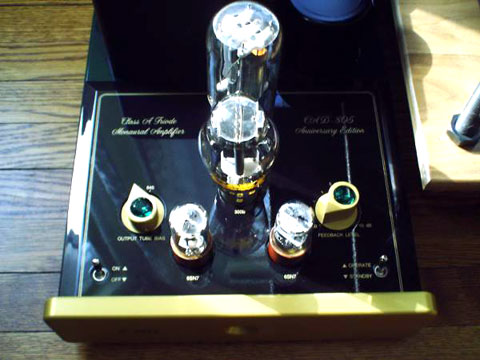
Up front and personal with a CAD-805
In back of the tubes the main real-estate of the 805 is occupied by two very impressively sized transformers—one power, and one output, and four capacitors the size of hefty cans of Jolt Cola—which is exactly what you would get, should you ever mess with them! Towards the back are also found two set-screws—one to adjust the level of juice to the 'cat's eye' display tubes, and the other for biasing purposes—along with the quarter inch jack for reading the bias on the 300B 'driver' tube. These are the only user adjustments you will have to worry about, other than choosing your output tube flavor.
The back panel offers a choice of 4, 8, or 16 ohm speaker outputs- that are very high quality and heavy duty, and the manufacturer name I can't remember for the life of me. There is an unbalanced input jack, (though you can order these amps in a balanced design as well), and two visible fuses—for the 300B and the output tubes. There is also a built-in fuse within the AC power socket, the power chords are detachable—natch!
There you have it, not overly complex, with everything in its place and handsomely displayed. And I do mean good looking! Especially in the Jaguar green chassis, Jaguar black faceplate combo I have got going. I do not think my pictures will do this justice, but I have tried to capture it. Some critics have called these designs 'retro.' To me they remind me of good medical gear- like the eye doctor I just saw recently uses, that you know costs a bundle, if you have ever tried to furnish your living room with medical gear. But I digress—the 805s convey an impression of first-rate American craftsmanship, an endangered species if there ever was one! It makes me feel good just to look at them, and that's without even turning them on.
Dennis Had credits Gregg Dunn at Cary with initiating the Jaguar series of enamel finishes that I was so taken with. Gregg filled me in: "I thought that we should move away from chrome finishes because it is not an environmentally friendly process and it also is hard to keep chrome looking good, long term... I was driving down the street in Cary (North Carolina) and was passed by a Jaguar XK-8 convertible that was the EXACT same color I was imagining in my head... I then took some old spare (Cary) chassis parts to a local auto body shop and had them painted in five different Jaguar paint finishes—Anthracite Black, Platinum, Bronze, Metallic Blue, and Carnival Red. We since used Carnival Red on the V-12 power amplifiers, and when we made the CAD-805 Anniversary Edition we chose Jaguar Anthracite Black."
I have now helped add Jaguar British Racing Green to the list—jolly good show old sport! As Gregg says, "It is possible to be good to the environment and to have good looking gear." Gregg wanted to know if they've been up and racing around my living room, and I assured him that they have.
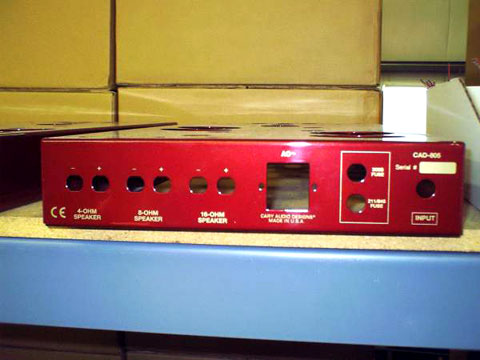
The back of a Jaguar Carnival Red 805 Chassis
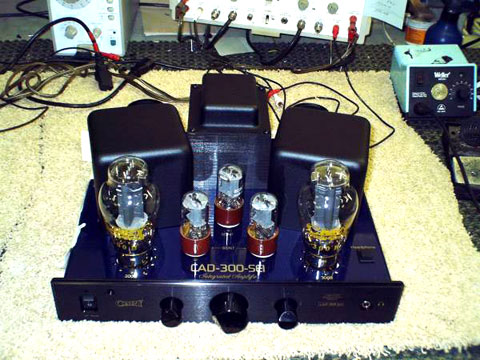
A metallic blue CAD-300 SEI
So how does it look and work on the inside? I have not cracked it open physically— that is an intimidating prospect. I asked Dennis Had to outline the internal signal chain from start to finish in the current CAD-805 Anniversary Edition, and he sums it up as follows:
"The single-ended audio input signal from the outside world is passed to the control input grid of the first 6SN7 tube. This first 6SN7 stage is operating in a parallel dual triode conventional resistance-coupled Class A amplifier. This first gain stage is directly coupled to the next 6SN7 dual triode gain stage. This second stage is operating in a series anode constant-current Class A amplifier. This amplified audio signal is passed through an oil-filled coupling capacitor to the grid of the 300B driver stage. The 300B triode tube operates in a Class A single-ended mode utilizing fixed negative grid voltage on the 300B driver stage. This negative grid voltage is user-adjusted by the screwdriver pot at the rear of the CAD-805 Anniversary amplifier. The 300B is directly coupled to the grid of either a 211 or 845, 100-watt plate dissipation, triode output tube. The method of coupling at this stage is called an interstage transformer. This is an air-gap design with a flat frequency response from 30Hz to 23 KHz. The audio signal from the 300B interstage transformer will drive the 211/845 output tube to 27 watts Class A output. With additional volume levels, the amplifier goes into a positive grid mode with a power output of 55 watts Class A2. In the case of the 211-output tube, the Class A2 power is on the order of 72 watts at clipping. The high power output from the 211/845 tube is coupled to the loudspeaker via an air-gapped 150 watt continuous duty output transformer. This transforms the high impedance, (8000 ohm primary winding ), of the output tube, to 4,8, or 16 ohms to drive the loudspeaker."
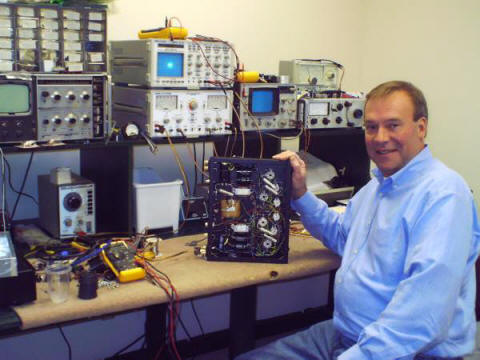
Dennis at the test bench with a Super Amp
When I visited with Dennis Had at his shop I asked him to recount the history of the permutations the 805 series has progressed through, from their inception in 1993, and Dennis described it thus:
"Briefly, the 805 is a 300SE with an afterburner.... There was the original 805. The driver tube in the original 805 was an EL34. Then because of the extraordinary success with the 300B tube in the 300SE single-ended amplifier, I then felt it was appropriate to go with the 300B as a driver tube- so then it became the 805B. Then came the 805C in 1998 after about three more years of improvements. Then there was a deliberate (new) design for the Anniversary Edition, which was to take those years of practical field experience, and put everything in the kitchen sink- including the ability to switch from the 211 (output) tube to the 845 (output) tube. And also two 6SN7 tubes in the input stage, instead of the previous one, for increased gain.
At the Apex
A couple of months back I made the trek, via schedule-challenged United Airlines, to Apex, North Carolina, to visit for myself the Cary Audio plant. I had been threatening to do this for some time, and the 805s provided me finally with an excuse. Dennis and the gang had the Jaguar Green pair built and ready for me when I got there. Some people have accused Cary Audio and others of having everything built in China. I can tell you that I personally witnessed the fabrication, assembly, and final testing process for a variety of Cary Audio products in action—and it sure wasn't China, it was Raleigh/Durham.
My visit to the Cary Audio home in Apex was made even more enjoyable by the time I got to spend with the entire crew there—Dennis Had's business partner Billy Wright, Dan Lilley the Director of Marketing, and Gregg Dunn, Director of Sales. The evening of my visit, the five of us closed down the local bar and grill there in Apex. You know you are with a bunch of devoted audiophiles when you spend a lively evening engaged in conversation about the past, present, and future of high-end audio—then look around, and find you are the only table left in the restaurant!
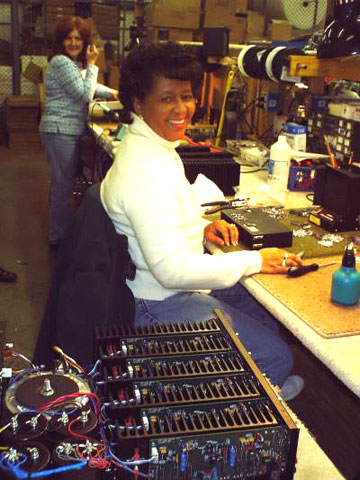
Karen builds a Cinema 5
Dennis Had led me on a tour of the Cary Audio plant soon after I arrived, and it is an impressive thing indeed to see all that wonderful gear come together, and meet many of the people who are directly responsible for doing that. The Cary approach is to have individual personnel dedicated to the complete start-to-finish assembly process for each different piece of gear, so certain people will do their 300 SEI model, for example, whereas someone else will build other units. Indeed, I met the woman who built my pair of CAD-805s. Her name is Nadine, and here is a photo. Thanks for the great job Nadine!
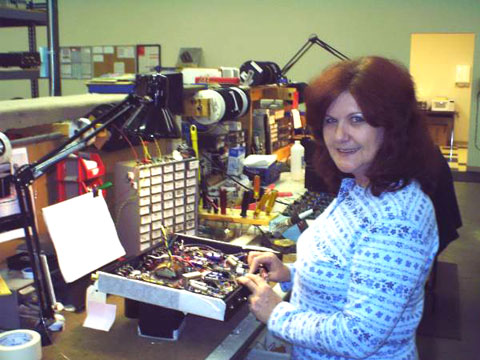
Nadine builds an SLI-80
I observed a number of interesting procedures in progress strolling through the 'Cary Toy Factory', as Dennis refers to it. Finished products go onto the 'burn-in' rack where they sit and learn to behave themselves- every unit that leaves the factory is checked for full operational specifications in full power-on mode for a period of time, and most of the voodoo issues related to burn-in are at least given a head start before a customer ever receives any unit.
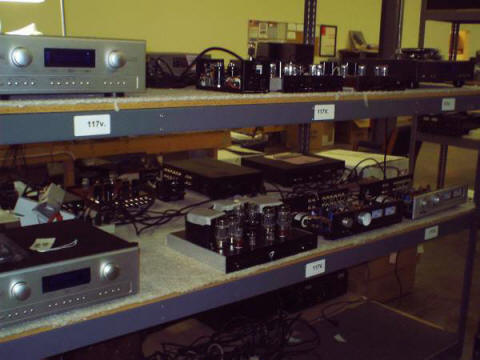
Units doing time on the burn-in rack
The silk-screening for component panels is done in-house. Enamel painting of chassis parts is done elsewhere by a sub-contractor. Here is a photo of Laura silk-screening component front parts.
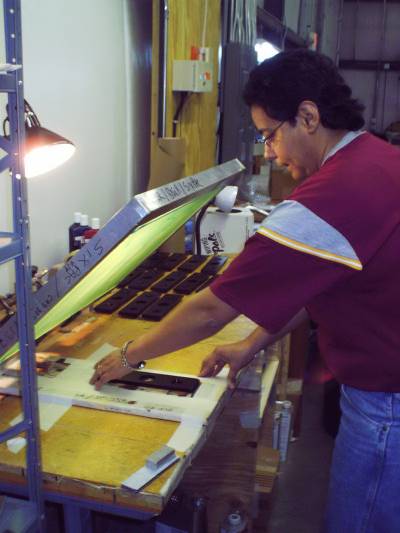
Laura Silk-Screening Panel Parts
Transformers in various sizes and functions are built to Cary specifications by a sub-contractor. Once they arrive in Apex and are ready for installation they are 'potted', literally a process of high-temperature wax-type material being applied prior to the transformers being popped into their containers. Here is a shot of Dennis Had standing next to the 'transformer potter'.
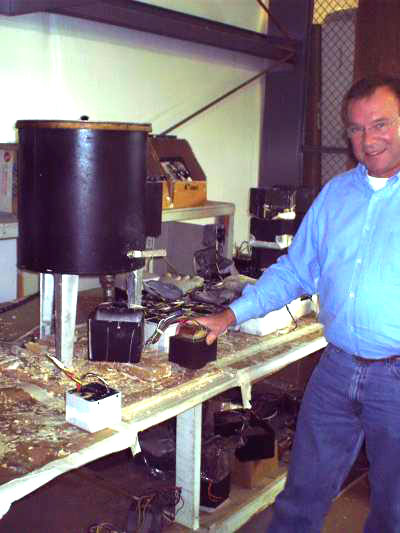
Dennis with the transformer potter
Dennis also likes to work out in his spare time by vertically pressing the very heavy 805 transformers, one in each arm. Here is a photo of Dennis in 'balanced mode.'
Buff audio rules!
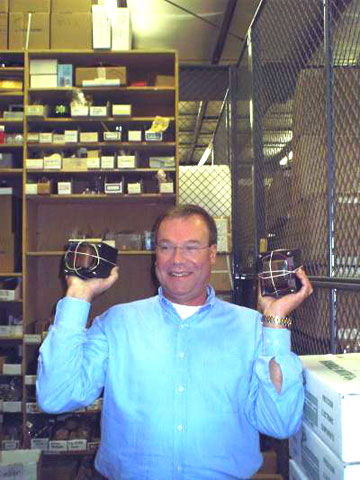
Dennis works out
An Ear-Opener
The CAD-805 Anniversary Edition monoblocks represent a concept and design that has evolved in a consistent real-world process, under conditions found in the marketplace, with the input of real-world listeners like you and me. What professional and non-professional customers have experienced over the years with the CAD-805 in continual production for well over a decade now has also changed. What a reviewer wrote at the time of an earlier version of these, or any other audio product, can legitimately be compared to what someone else like me might find at a later date. From their inception, the CAD-805 has drawn the attention of high-end critics and consumers alike. There is in fact a rich trove of prior articles about previous models of the 805s; when I did a search, I came up with almost 40 pages of material from the Stereophile website alone. However, most of these reviews address prior models in the series; Sam Tellig alone among noted audio writers recently has commented in print on the current CAD Anniversary Edition 805.
I feel it is relevant to cite a few previous comments, as informed as the writers may be, as I feel that given real-world evolution of the designs they are in some cases no longer valid, based on my extensive listening with the current edition of the CAD-805. In particular, critics of tubed single-ended designs have sometimes taken those designs to task, particularly in the area of low bass. Lack of 'bass extension' has been viewed, at least in the past, as somehow sui generis as far as zero-feedback triode single-ended designs go. Dick Olsher first wrote in Stereophile about the earlier version of the 805: "As far as fleshing out an orchestral foundation, the deep bass lacked full extension and impact." In 1994, Olsher wrote again about the 805: "Single-ended tube amps aren't known for their bass extension and impact, so don't expect killer bass if you buy one." Martin Colloms jumped into the fray in 1994 by adding: "Single-ended triodes will lead you to madrigals and string quartets with a renewed appreciation, but after a while you'll find that Laurie Anderson, Little Feat, Miles Davis, Stravinsky, Mahler, and Joe Cocker no longer figure on your CD playlist".
Well now! I am here to tell you that this may have been the case with previous models of the 805 series to some extent- I can't comment one way or the other, not having spent time with those earlier versions of the design, but it is time to set the record straight loud and clear about what is going on right now. In my case, Laurie Anderson and Joe Cocker never figure on my play list and never have, so those artists are a moot point. But Mahler?! I can honestly tell you that I have been playing more Mahler than ever before with the CAD-805 Anniversary Edition amps in the house. The Tilson Thomas series of the symphonies has been a mind-blowing odyssey with the 805, ushering me into a realm of orchestral reproduction that is absolutely stunning and deeply moving emotionally. Huge powerful low-end as deep as the Grand Canyon—the best reproduction of low orchestral strings and brass I have ever heard! Any lingering issues related to low-end extension, damping, and output power on transients have been fully resolved by Dennis Had's current design for the CAD-805. It is startling and breathtaking when those huge crescendos on these recent standard-setting San Francisco Symphony CDs kick in with all their stupendous knock-your-socks-off glory! I am not kidding now, I mean it.
Little Feat you ask? Rockin' hard, sweet, and kickin' in my living room last night as I went to confirm what I already knew—if it's 'good-rockin' tonight' you desire, you came to the right place with the 805. But, if like me, you like both having and eating cake, the sweet funky subtle sound of Lowell George's slide playing on the entire Dixie Chicken album was just too sexy and outstanding for words—more like a really fine Manhattan made with Knob Creek- the same drink I had them put in front of Dennis Had when we went out to dinner in Apex actually. Sort of a Yankee/Dixie peacemaker!
Mr. Colloms mentions Miles? Well, Miles and I go way back in the alley. I have to admit it is a little unsettling when I'm listening to that great Columbia box set of the complete Bitches Brew sessions, and there he is standing in front of me with that low raspy voice saying "Sasha you motherf#&#@, let's hear some of that back!"
That is just the tip of the aural iceberg I have been living with these past weeks. There is an across-the-board sit up and pay attention quality to the sound that simply glues one to the spot. Not a tipped-up on either end of the frequency spectrum thing—not that sort of 'loudness' EQ curve that some less-than-stellar gear seems to create, but a full-throated aliveness that is almost surreal in it's harmonic integrity and loveliness, and completely evenly distributed. There is a total consistency across the entire frequency spectrum that I have not heard surpassed, with no real limits on either end. Is there any reason why you would need more power? Perhaps, if you own very large/and or inefficient full-range speaker systems, live in a basketball arena, and your musical priority list places 'slam' and such factors at the top. Mine does not, and I am getting more 'slam' than I know what to do with! These things rock hard, but they also sing, sigh, and do the minuet. They also play a mean Delta Blues too; try some Muddy Waters on these, like Folksinger, and prepare to take a little trip to Chess Records and South Michigan Avenue.

S. M. with the 805s at the Cary listening room
Bringing It All Back Home
One of the built-in variables to Dennis's current CAD-805 design is the deliberate choice to supply with the units two different pairs of output tubes—the 211 and the 845—and you the listener get to decide which to utilize. User ease is assured by including on the top panel a rocker switch that allows you to swap the bias setting for them easily. It is necessary however to allow the units to cool for at least half an hour before swapping the tubes—for heat and voltage safety reasons. I usually change them overnight. What are the results? Sonically, the lower output 845 provide a slightly more 'romantic' sound, as Dennis describes it, and I would agree with that choice of adjective. The higher-powered 211s are fantastic at extracting every last bit of sonic juice out of those huge Mahler recordings—that is how I find I enjoy them most; you do get noticeably more dBs of output with the 211. Over time the way it has broken down for me is: the 211 for orchestral works, and the 845 for jazz and pop recordings where the latter pair of output tubes provide the extra bit of subtleness that I think benefits tenor sax recordings for example—female vocals as well. It's a wonderful extra dimension you get standard with these units; both sets of output tubes are included in the sale price. For the 300B driver tube stage you get Cary Audio labeled 'valves' that have been made to Cary specs; this was in part because of the lack of new availability for the vaunted Western Electric tubes. The Cary 300Bs sound great—you don't need to fret about that!
I asked Dennis Had about other design parameters related to these amplifiers and he commented that " With the huge power supply, that amplifier is a Class A amplifier, and we're drawing full-throttle all the time. And with the dynamics of the 805, which can go into Class A2 on extreme dynamics, so the power reserves with the huge electrolytics are useful." I mentioned to Dennis that I felt consumers often got tricked into using the terms 'Class A' and so forth as value judgments rather than in any accurate technical sense, and I asked him how those categories applied to the CAD-805. Dennis responded: "The 805 Anniversary Edition runs in Class A1 up to about 27 watts. As you are listening, and most of your listening is in 2 or 3 watts anyway, if you are approaching a full-scale dynamic like a kettle-drum, the amplifier will go all the way up—and in the case of the 805 that is close to 70 watts that it is capable of with the 211 output tube, in what is called 'Class A2.' The only way you can have a single-ended amplifier do that is operating with a tube like an 845 or 211 that is transformer-coupled. The output transformer on the 805 is of a size that if that were a push/pull amplifier it would easily be a 300 watt amp!"
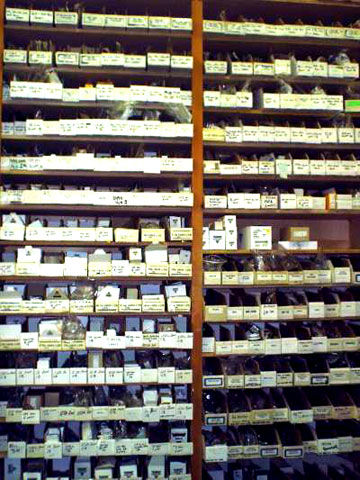
The wall of parts
Dennis mentioned that the 805s are entirely 'direct-coupled', and I asked him to comment on the utilization of that approach. Dennis responded that the benefits include: "Speed and dynamics. Frequency extremes. The front-end tubes are direct-coupled to the 300B. The 300B is hooked to an inter-stage transformer that is directly coupled to the input of the 845 (or 211) output tubes. The Anniversary 805 is all direct-coupled, from input tube to the output tube. Just picture a 300SE, (Note: these are the Cary Audio monoblocks using 300B tubes for output that are rated at 15 watts), with the output transformer hooked into the speaker. Take that same 300SE and instead of an output transformer after the 300B tube there is an interstage transformer—high impedance to high impedance—which drives the 845 or 211 tubes in a linear fashion. The 845 (output tube) will produce listenable output power up to about 55 watts, the 211 will produce power up to over 70 watts."
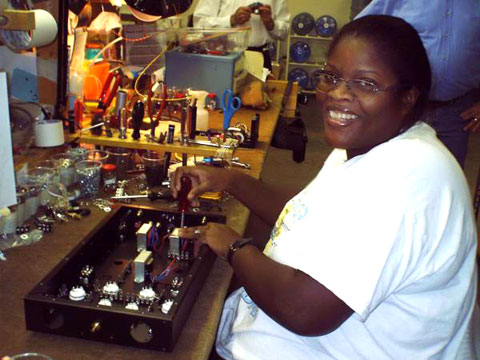
Debra makes a Rocket 88
The Future of Music
That's a lot of single-ended triode juice my friends! And the single-ended aspect is playing a role in this; the lack of disruption in the continuity of waveforms, as opposed to the inherent nature of 'push-pull' designs, I feel is directly related to issues of musical impact and quality. Yes, a watt is a watt, and a dB is a dB, and these things get measured, (not by me but by somebody), but there is something else going on here at a deep psychoacoustic level. It relates to matters of musical fatigue as well— the CAD-805 definitely can be listened to louder and longer than other amplifiers. I know this because I've been doing it. If you have the opportunity to spend time with these amplifiers, you will hear that they actually do 'create life-size images' as Dennis Had is fond of saying. I went so far as to ask Dennis if he had hidden a Fender spring reverb unit in there somewhere, and he told me that I wasn't the first person to ask him this! Dennis actually attributes most of the holographic sonic imaging ability of the 805s to the lack of global negative feedback in the circuit—you can add it in if so desired in continual 1 dB increments, but Dennis feels that most listeners do not—I am certainly in that category. The use of negative feedback immediately starts to shrink the sonic picture, like throwing the baby out with the bathwater!
Do the CAD-805 Anniversary Edition amplifiers have the capacity to respond to up-stream changes? Yes, and how! I just upgraded my Rega Planar 25 with several very effective modifications. How do I know they were effective? Because the 805 instantly revealed every swap and its exact contribution to the musical picture, from the platter mat switch I made, to the outboard turntable power supply. The mighty 805s are not imposing their own sonic signature so much as they are allowing everything that comes into them to live up to it's full musical potential. This can include downsides from time to time. If a particular recording sucks, it will continue to do so, and you will hear exactly what sucks about it in great detail.
Let us talk about value, and things that are true and important in life. If someone came up to me today, and offered me the choice between an old Jaguar and a new pair of CAD-805s both finished in Jaguar Racing Green, I can honestly say I would choose the Cary! You have to get your priorities straight. For me, as a musician, composer, and professor of music, music has to win out—even though I would really like that old Jaguar someday. When you purchase a product of such refinement and musical power as the CAD-805s you are benefiting from years of designer creativity and insight—not only nuts and bolts. You are paying for the artistic and craft work that designers like Dennis Had put into their creations. That is the true marker of their commitment, and of yours. If it is worth it to you, and you feel in your gut that you are connecting on a musical level to music technology of this order of quality—or to that of some other designer and manufacturer for that matter—then go ahead on I say; at least you aren't out gambling or chasing women! (I know, I tried this logic with my wife and it only got me so far....)
But boy oh boy! When those strings start to sing in the Mahler, or Ella Fitzgerald hits those low notes on Spring Can Really Hang You Up the Most, or The Band kicks it off on their second album with Jemima Surrender, or those great first thunderous speaker-stretching low notes from Phil Lesh sail in off my original LP pressing of Dark Star, or when Mighty Sam McClain growls out "And all my pain is by my own hand" from the great Give It Up To Love album—when all that happens and more, you know that the red light is on and it's magic time, because the CAD-805s are in the house. Dennis Had is a genius. What do geniuses do? They create masterpieces. The CAD-805 Anniversary Edition Class A Triode Monaural Amplifiers are a masterpiece!
And now I have to find a really good florist for that anniversary in July.
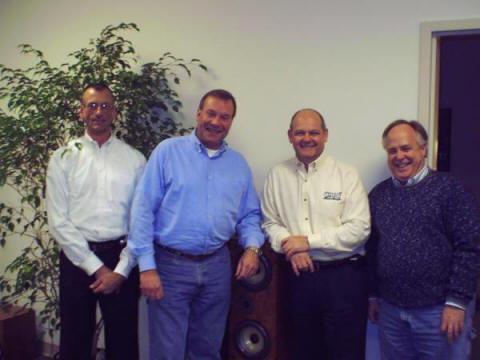
Dan, Dennis, Billy, and Gregg at Cary Audio
CAD-805 Anniversary Edition Class A
Triode Monaural Amplifiers
Retail: $11,000 per pair
Cary Audio Design
1020 Goodworth Dr.
Apex, NC. 27539
TEL: 919. 355. 0010
web address: www.caryaudio.com
